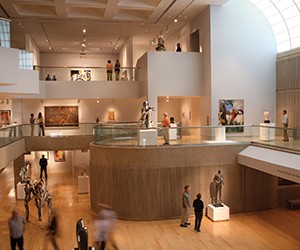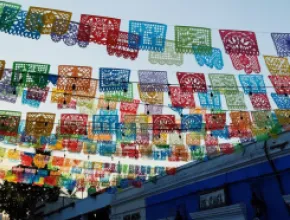Since the 1920s, sleek, modern homes that blend with the desert environment have been built in Palm Springs and the neighboring desert cities. Today, Palm Springs has the country’s largest concentration of Mid-Century Modern architecture, which has become a symbol of the city. The style is notable for its use of glass, clean lines and indoor/outdoor spaces and has expanded from private homes to hotels, resorts and venues across the Coachella Valley.
Although much of the architecture of the desert cities has been preserved, the region’s accessibility, amenities and resources have modernized and made Palm Springs a destination for meetings, conventions and business travel. Group business is booming at the 261,000-square-foot Palm Springs Convention Center, which was relaunched in 2005, after an extensive $32 million renovation and expansion, and is now within walking distance to 1,600 hotel rooms.
As for convenience, Palm Springs is located just over 100 miles from both Los Angeles and San Diego, the Coachella Valley and has always been a getaway for Southern California residents. However, now, especially with the recently announced news of Virgin America offering year-round nonstop service to and from San Francisco and JetBlue flying nonstop to and from New York City through the high season, the desert is more accessible than ever.
Local History
The main building of the Parker Palm Springs was California’s first Holiday Inn in 1959. It has had many incarnations, including Gene Autry’s estate, the Merv Griffin Resort, the Givenchy Hotel and Spa and now the Jonathan Adler-designed destination resort hotel. With those names and the two-story concrete brick facade featuring bright oversize orange doors that welcome guests as they arrive, you know you are in Palm Springs. The hotel and grounds are a nod to different important eras of the city with modern amenities and facilities.
Spread over 13 acres, the property has 144 rooms and features a new 6,000-square-foot building that can be used for meetings and events. In addition, the expansive lawn and garden areas can be used for receptions and banquets. The 3,700-square-foot Grand Ballroom can accommodate up to 400, has direct access to the gardens and features a glass wall. The smaller Murphy’s Room, Mafiya Suite and breakout rooms offer flexibility for events, meetings and smaller receptions and banquets.
In the early 1920s, businessman Walter H. Morgan purchased 1,400 acres in the east end of the Coachella Valley from the native Cahuilla Indians for what is now the La Quinta Resort & Club. With the help of architect Gordon Kaufman, among others, he created a hacienda-style hotel. The word spread quickly in Hollywood of this secluded retreat outside Palm Springs and stars like Bette Davis, Clark Gable and Greta Garbo were all frequent guests. Frank Capra often stayed at the resort to write and called it the “Shangri-La of Screenwriting”.
Set against the Santa Rose Mountains, the Waldorf Astoria resort is made up of 796 hacienda-style casitas, suites and villas grouped around 41 pools. There are five golf courses on property, including the TPC Stadium Course at PGA WEST. The 190,000 square feet of indoor and outdoor event space includes the 17,000-square-foot Fiesta Ballroom and the 16,000-square-foot Flores Ballroom. The 25,000-square-foot lawn space can host up to 2,500 guests and the historic La Casa area, a former private residence—Garbo’s preferred accommodation—has a nearly 8,700-square-foot patio and adjacent courtyard, perfect for themed and special events for groups up to 1,000.
The Riviera Palm Springs, a Tribute Portfolio Resort is another property that served as a playground of the past. Opened in 1959 on 24 acres and modeled after Vegas-style hotels, the resort was frequented by Rat Pack icons, such as Frank Sinatra, Dean Martin and Sammy Davis, Jr.
In November 2015 the 398-room hotel became a Tribute Portfolio Resort, a Starwood Hotels & Resorts collection of independent hotels. Prior to the brand change the property underwent a renovation including the addition of a new pool bar, pavilion and redesigned lobby.
The resort features more than 52,000 square feet of meeting and event space including a 19,670-square-foot ballroom and 15,000 square feet of outdoor space. Circa 59, the resort’s restaurant, offers eco-friendly seafood, meats and locally grown produce from the Coachella Valley. On-site bars and lounges include the Starlite Lounge, a spot for a classic cocktail or nightcap, and Sidebar, with a resident mixologist.
PageBreak
Mid-Century Modern Mecca
Much of the design and architecture in the city can be seen in residential homes and commercial buildings. Palm Springs Mod Squad, run by Kurt Cyr, offers groups tours of the works of art by William Cody, Albert Frey, Hugh Kaptur, William Krisel, Donald Wexler and E. Stewart Williams. Cyr is a designer, Mid-Century Modern expert and co-founder of Salon for the Parched, a monthly creative think tank, and Makerville, an artisan group that produces events for the annual Modernism Week.
“Though many great architects have designed and built in Palm Springs, there are six local architects that stand out as those who helped create the mod architectural look of the city,” states Cyr.
Mod Squad can join a group on a chartered bus to not only show the desert homes of Frank Sinatra, Dinah Shore and Elvis Presley, but to also explain how the area’s history and architecture are related.
“The Essential Palm Springs Tour showcases the local architects that shaped the Mid-Century look of Palm Springs,” says Cyr. “Along the way, you’ll see how the light and landscape helped guide these architects to create a version of modernism specifically suited to the California desert.”
For a more intimate tour, groups of five hop on the Mod Squad mini and have access to smaller streets that larger buses can’t navigate.
An Art Hub
Founded in 1938 as the Palm Springs Desert Museum which focused on Native American relics, natural sciences and artifacts from the surrounding Coachella Valley, the space is known today as the Palm Springs Art Museum. Its attention has been shifted to world-class art housing works from Marc Chagall, Pablo Picasso, Andy Warhol, Roy Lichtenstein and Ansel Adams. In addition to the collections, the museum’s 433-seat Annenberg Theater makes the facility a great combination of visual and performing arts.
The museum’s main building in downtown Palm Springs was designed in 1974 by architect E. Stewart Williams while two other locations have been added since—the Architecture and Design Center also downtown and the Palm Springs Art Museum in Palm Desert, which is home to the Faye Sarkowsky Sculpture Garden, all are open to groups.
In the main building, the 433-seat Annenberg Theater can accommodate keynote speakers, screenings, seminars and entertainment. The Muse Cafe is adjacent to the theater and can be rented for smaller gatherings. The Elrod and Marcuse Sculpture Gardens offer a beautiful setting for receptions while the central atrium can accommodate up to 500 guests.
Professional technicians are on-hand for audiovisual needs and the museum works with top Palm Springs caterers.
“Our preferred caterers have been selected for their excellent cuisine, attractive presentation, great service and attention to detail assuring you a very special event,” explains Bill Ransom, special events manager.







